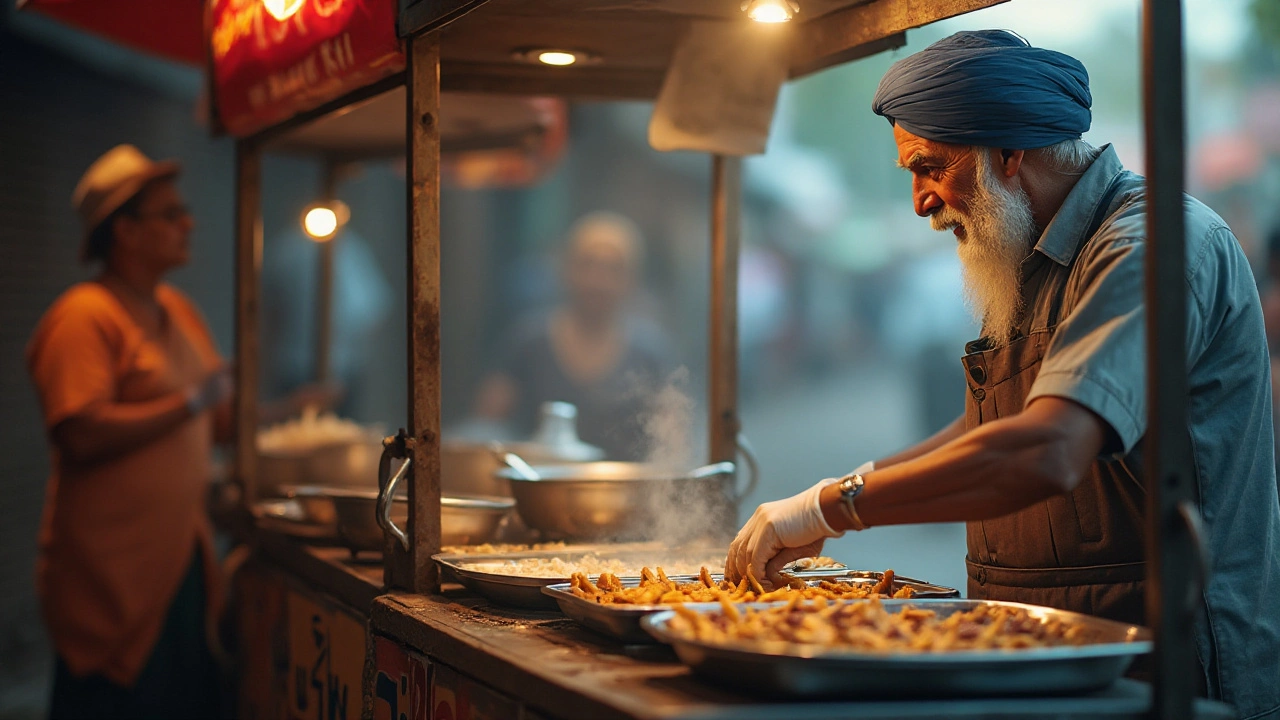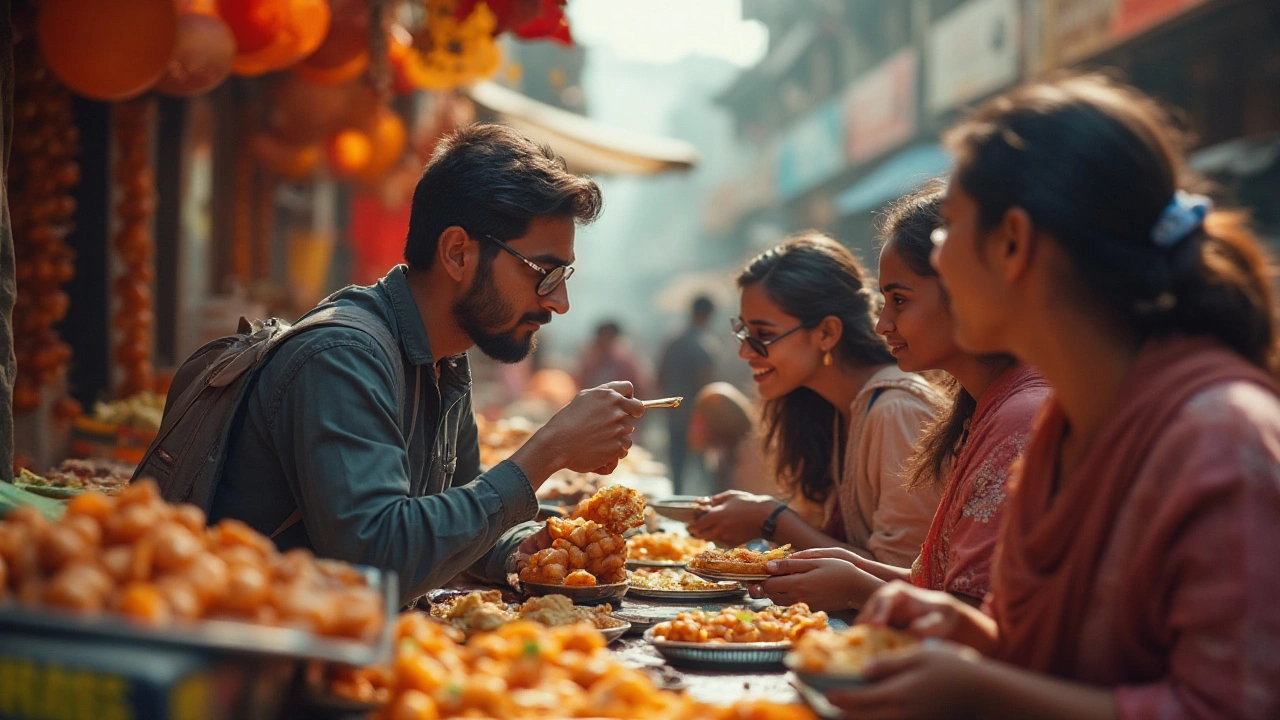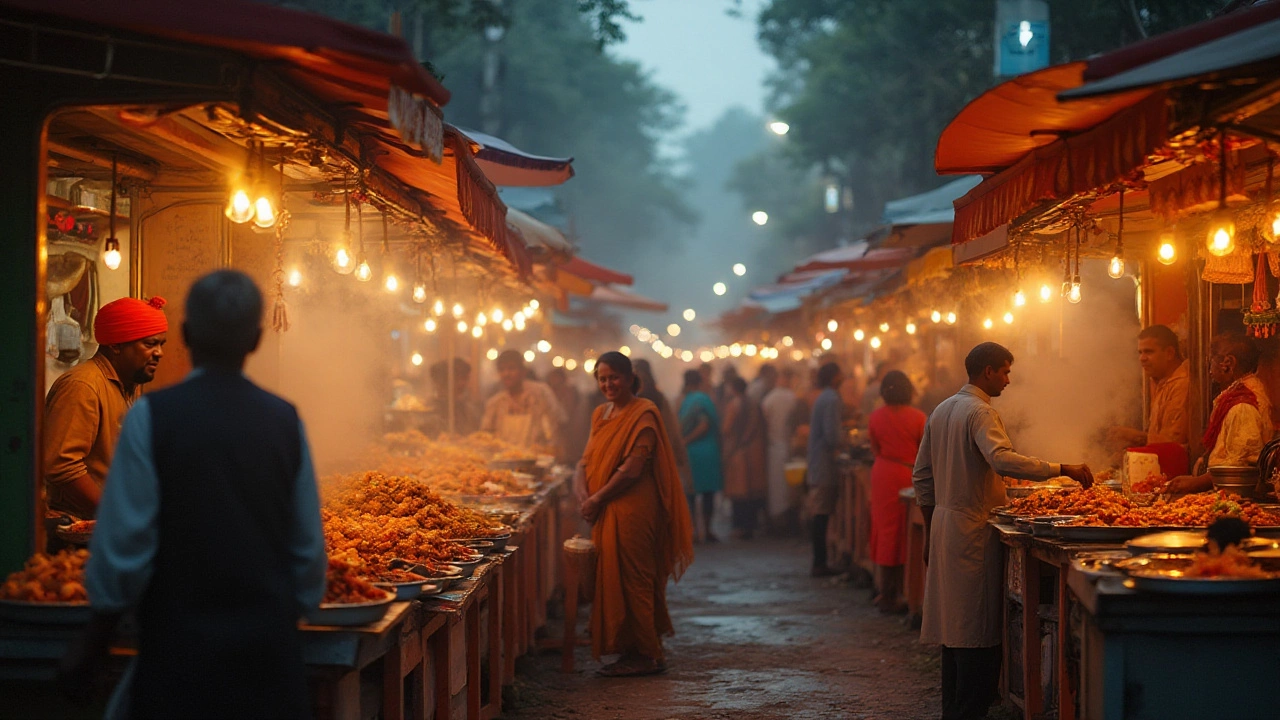Imagine wandering through the vibrant streets of India with mouthwatering aromas enveloping you from every corner. The sizzling of skewers, the tangy allure of chutneys, and the crispy crunch of samosas tug at your senses, promising an unforgettable culinary journey. However, amidst this culinary carnival, it's crucial to prioritize your safety.
This guide is designed to ensure you relish every bite of India's famed street foods without any unfortunate mishaps. It tackles the essentials of choosing reliable vendors, recognizing safe food handling practices, and putting the joy of discovery at the forefront. Understanding the dance of flavors can be electrifying, and with some simple precautions, it's a journey worth every step.
- Understanding Indian Street Food
- Choosing Reputable Vendors
- Observing Hygiene Practices
- Opting for Freshly Cooked Items
- Trusting Your Instincts
Understanding Indian Street Food
Indian street food is a carnival of colors, flavors, and textures that reflects the diverse culinary traditions of this vast nation. Each region in India boasts its own distinct street delicacies, which are often as unique as the communities they originate from. Whether it's the spicy Jalebi spinning in sizzling oil in the north, the tangy, coconut-infused flavors of Bhel Puri in Mumbai, or the melt-in-your-mouth Idlis of the south, every street vendor presents a tale of taste.
What makes street food India so special is its ability to bring affordable and authentic flavors to everyone, often with a twist of innovation. On the bustling corners of cities and towns, vendors masterfully whip up dishes that are not only easy on the wallet but also exploding with flavor. These dishes, frequently served on biodegradable banana leaves or durable steel plates, encourage communal eating and forming bonds over shared tastes. Often, locals gravitate towards specific stalls renowned for family recipes passed down through generations, creating a fierce loyalty that fuels the street food culture.
Street Food as a Cultural Meeting Point
Indian street food is more than just a culinary experience; it is a cultural melting pot. Street food stalls and markets are gathering places where people from all walks of life mingle, eat, and enjoy. The camaraderie between vendor and customer is palpable, with discussions flowing about cricket scores, local politics, or the day's weather as naturally as the culinary transactions. No matter where you're from, you're bound to meet someone with a story, a recommendation, or a cherished memory tied to the tastes of the streets.
"Street food in India is as vibrant and varied as the country itself. Each dish tells a story, each stall a page from the community's cookbook," says celebrity chef Ranveer Brar, capturing the rich tapestry of street food India.
The essence of Indian cuisine is deeply embedded in these aromatic stalls, which sometimes experiment with flavors and interpret classic dishes in new ways. It's not uncommon to find a vendor putting a contemporary spin on traditional recipes, blending international influences with local spices. This reflects the evolving palate of modern India, which is as open to global flavors as it is rooted in tradition. As tourists and locals alike dive into the bountiful variety, they participate in an ongoing conversation of flavors, traditions, and stories that span centuries.
Choosing Reputable Vendors
Embarking on a journey through India’s street food scene demands a keen eye for authenticity and safety. Ensuring that you select a vendor who meets these criteria can make all the difference between a memorable culinary experience and an unwanted encounter with digestive distress. One effective approach is to observe the vendor's stall closely. A bustling customer queue is often a good sign that the stall is reputable and trusted by locals. The turnover of food items will likely be high, which helps in keeping the ingredients fresh. Moreover, stalls with returning customers are often a testament to their service quality and trustworthiness.
Another crucial element to consider is cleanliness. Essentially, how a vendor maintains their stall is a mirror to their commitment to safe and hygienic practices. Watch for visible cues, such as whether they handle money and food with separate hands or gloves. Vendors who incorporate these practices are often more meticulous and aware of hygiene, reducing potential contamination risks. Take note of their cooking area—vendors with covered utensils and proper waste disposal systems are typically more attentive to food safety standards.
"The way a vendor manages their stall can tell you volumes about the quality of the food they serve," says culinary expert Ritu Sharma. "In my experience, vendors with repeat customers and visibly clean practices tend to be the safest bet for enjoying street food."
Consistency and Location
A consistent location for a vendor can signal reliability and regularity. Vendors operating in the same spot tend to build a reputation over time, which can be a pretty solid indicator of their dependability. A spontaneous shift in location for a vendor can sometimes point to other issues, so sticking to established stalls can be an uncomplicated precaution. Additionally, markets located in more populated areas often fall under local health scrutiny, which can boost assurance in their standards. Trust your instincts as you explore. Your senses, coupled with these practical observations, will guide you towards the safe and irresistibly delicious street food that India's culinary tapestry offers.
Observing Hygiene Practices
Street food in India is a whirlwind of flavors and surprises, a dance performed amidst the vibrant chaos of life. As exciting as this culinary journey is, paying attention to hygiene practices can make all the difference in ensuring a delightful experience. Hygiene is paramount, especially in bustling markets where the lines between food and adventure blur. It starts with something as basic yet fundamental as washing hands before and after eating. Carrying a small bottle of hand sanitizer can be a game-changer, making it easy to keep your hands clean even when water isn't readily available.
One often overlooked aspect when enjoying the local street food India offers is the condition of the stall itself. A careful observer can glean a lot about the hygiene practices of a vendor by simply watching their setup and operations. Look for stalls where the food is covered and protected from flies and dust. Freshness should be a key consideration—stalls that display a wide turnover of customers often have a high rate of food replenishment, ensuring what you eat hasn't been sitting out for too long. Watch how they handle money, if they have designated people to handle different tasks, which can reduce the risk of cross contamination.
Inspect the Preparation Area
Another aspect is the chef's personal hygiene. Vendors who wear clean clothing and gloves can often be trusted more than those who don't. Such simple indicators can significantly influence your decision on whether or not to indulge in their offerings. A tidily organized stall with fresh ingredients is a promising sign. One patron of Indian street cuisine opined,
"It's the little things that count—seeing food prepared with care makes a big difference in enjoying street spreads safely."Anticipating seasoning and garnish levels can also aid—sometimes when a food item is lavishly garnished, it might be to obscure something off about it. Trust your instincts based on what your senses tell you.
In the vibrant tapestry of street food culture, ensuring that chefs handle ingredients with clean utensils is critical. Watch out for stalls where the same hands are used to handle both raw and cooked food. This can minimize contamination between fresh produce and cooked items. However, if you notice the cook uses different tools and adheres to thorough cooking procedures, it can be an encouraging sign. Another tip is to avoid foods that tend to spoil quickly in heat, such as those with dairy or eggs. Prioritize enjoying piping hot offerings, as heat often kills many pesky pathogens.
The Role of Water in Hygiene
An often underestimated aspect is the use of water. Street vendors rely heavily on local water supplies, which may not be safe for all travelers. Always opt for foods that have been boiled or cooked at high temperatures. Be cautious with uncooked fruits and vegetables unless you can peel them yourself. Having bottled water handy not only satisfies thirst but also serves as a reminder to stay vigilant against potential contaminants found in other beverages. The importance of assessing how food stalls use water in cooking and cleaning their utensils cannot be overstated. Keeping these considerations in mind can make your street food journey not just memorable, but health-friendly too.
Lastly, observe how waste is dealt with. Vendors mindful of their environment often care about the health of their patrons. Low tangles of garbage are a positive indicator of consciousness about the surroundings, reflecting a practice often imbued into the ethos of their food preparation. When in doubt, consult locals or fellow travelers—those who've gone before you often have invaluable insights regarding safe places to eat, weaving another thread in the tapestry of India's street food narrative.
Opting for Freshly Cooked Items
Diving into the bustling world of street food India can feel like an adventure into the exotic and the unknown, where each stall offers a unique culinary delight. However, when it comes to keeping food safety top of mind, the golden rule is to choose food that is freshly cooked. Freshly prepared food not only tantalizes your taste buds with authentic flavors but also reduces the risk of foodborne illnesses. The heat from freshly cooked items tends to kill most bacteria and pathogens, making it a safer bet. Whether it's hot-off-the-pan pakoras or piping-hot pav bhaji, eating fresh can significantly enhance your street food experience.
The sensory cues also play a big role here. As you navigate through crowded markets, listen for sounds that indicate cooking in progress—a sizzle or a crackle is music to your ears! The sight of steam rising can be equally assuring. Vendors who cook items in front of you are usually good choices, as it showcases transparency and hygiene. Additionally, choose seasonal foods as they are less likely to have been stored improperly. Street food culture in India thrives on freshness, and tapping into that ethos usually leads to delicious discoveries.
Be aware of dishes that may have been sitting out for a while. Lining up at stalls during peak hours is often a signal that food is prepared in batches for a continuous flow of customers. Busy times can improve your chances of grabbing items made fresh in quick succession. Opt for stalls that show brisk activity, as the turnover means that whatever you eat hasn't been languishing on the counter.
The significance of freshly cooked items in maintaining quality and safety is shared by many food experts. A famous Indian food critic once noted,
"The secret to enjoying delectable street food is to chase the grill or the wok tirelessly—wherever you see flames, you’re bound to find heat-kissed flavors that promise both taste and safety."There's wisdom in choosing what's cooked right before your eyes. So, when navigating the savory world of Indian street food, keep the focus on dishes served with that just-cooked vibrancy.
For the adventurous soul eager to savor authentic Indian cuisine, understanding the nuances of street food is imperative. With India being a country of myriad spices and flavors, each dish narrates a story steeped in tradition and taste. Adhering to the guideline of selecting freshly cooked items can ensure not just a safe culinary excursion but a memorable one too. It allows you to immerse yourself into the local culture while safeguarding your health.

Trusting Your Instincts
Amid the whirlwind of enticing aromas and vibrant colors, trusting your instincts is perhaps the most undervalued skill when enjoying street food in India. Our senses have evolved to warn us against potential dangers, and when it comes to food, a keen instinct can be your best guide. For instance, if a stall looks unsanitary or the smell suddenly changes to something less appetizing, it's perfectly okay to move on despite how delicious the offerings might appear. Listening to these subtle cues can save you from culinary mishaps.
When navigating the bustling streets, keep an eye out for food stalls surrounded by locals. A long queue is often an endorsement of freshness and quality. Vendors with a loyal local clientele tend to maintain high standards as their reputation hinges on repeat business. Another red flag to be cautious of is the presence of flies, which are more than just a nuisance—they can suggest poor hygiene and the possibility of contamination. It's always advisable to steer clear in such scenarios.
The Importance of Sight and Smell
Remember, your sense of smell is a powerful ally. A dish should have an inviting aroma; anything that smells off or rancid is a signal to skip it. Similarly, pay attention to the sights; observe whether the food appears fresh or if it's been sitting too long in the sun. There's no shame in being choosy; after all, it's about a balance between adventure and caution, especially when exploring the diverse Indian cuisine.
“Trust yourself. You know more than you think you do.” – Dr. Benjamin Spock
Beyond sensory instincts, knowledge of food safety can further empower your decisions. For example, cooked food is generally safer than raw due to the high temperatures that eliminate most bacteria. Embrace piping hot dishes like dosas, freshly made parathas, or hot-off-the-grill kebabs. Steer clear of street vendors selling pre-packaged food or those reheated multiple times, as these often carry a higher risk of contamination.
| Region | Popular Safe Dishes |
|---|---|
| North India | Hot Parathas, Fresh Chole Bhature |
| South India | Steaming Idlis, Dosas |
Lastly, an often-overlooked practice is carrying some hand sanitizer or wet wipes to mitigate the risk of germs. Street food environments are usually not the most sanitized, so a little precaution goes a long way. As you embark on your street food adventure, blend your instincts with sensory observations, and you'll find the experience both safe and enriching.
